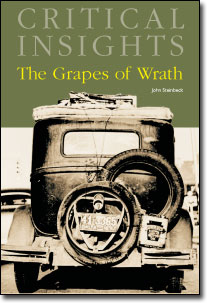
|
Critical Insights: The Grapes of Wrath
Edited
and Introduction by Keith Newlin
Salem
Press, 2010.
ISBN:
978-1-58765-715-3
ABOUT
THE BOOK
Easily
the most famous of John Steinbeck's novels, The Grapes of Wrath
has stirred considerable controversy ever since it was first published
in 1939. On one hand, some readers and critics have berated it as, at
best, mere "proletarian fiction" and, at worst, leftist
propaganda; on the other hand are those who have celebrated the novel as
a major artistic achievement that interweaves sharp social criticism
with a mystical vision of humankind and the natural world. The novel has
been both banned and commended, both dismissed by critics and called
"the story of the human race."

Edited and with an introduction by Keith Newlin, Professor and Chair of
the Department of English at the University of North Carolina
Wilmington, this volume in the Critical Insights series brings together
a variety of new, classic, and contemporary essays on this major
American novel. Newlin's introduction compares the responses of the
novel's early reviewers with those of actual Dust Bowl migrants, and,
writing on behalf of The Paris Review, National Book Award winner
Ha Jin celebrates Steinbeck's remarkable artistry.

For readers studying The Grapes of Wrath for the first time, a
quartet of new essays offer a comprehensive introduction to the novel's
key themes, social context, and critical history. Jennifer Banach
relates the novel to the American protest tradition, arguing that,
though the novel is deeply concern with social issues, it ultimately
transcends them with its communitarian vision. Matthew J. Bolton focuses
on how it fuses narrative strategies from both protest and modernist
literature. Mike Wentworth offers a detailed overview of the Dust Bowl
and migrant worker crisis in California to show how, beyond these
temporal circumstances, the novel participates within larger traditions
of the American road novel and the migrant narrative. Finally,
Camille-Yvette Welsch offers a comprehensive survey of Steinbeck
criticism.

The volume continues with a selection of classic and contemporary essays
on the novel. Frederic I. Carpenter describes how Steinbeck blends
together major strands of American philosophy, from Ralph Waldo Emerson
to William James and John Dewey. Martin Shockley and Eric W. Carlson
treat the novel's Christian symbolism. Peter Lisca, Howard Levant, and
John H. Timmerman analyze the novel's structure, form, and language.
Warren Motley shows how Ma Joad transforms the Joad family into a
cohesive matriarchy, and Donald Pizer locates the novel as an heir to
literary naturalism. Robert DeMott draws on Steinbeck's letters and
papers to discuss the novel's composition, while Keith Windschuttle
offers a detailed description of the actual Okie migration to cast doubt
on the veracity of Steinbeck's fictional portrayal of migration.
Finally, Charles Cunningham reassesses the novel's politics, and Vivyan
C. Adair analyzes Steinbeck's feminine archetypes.
|
